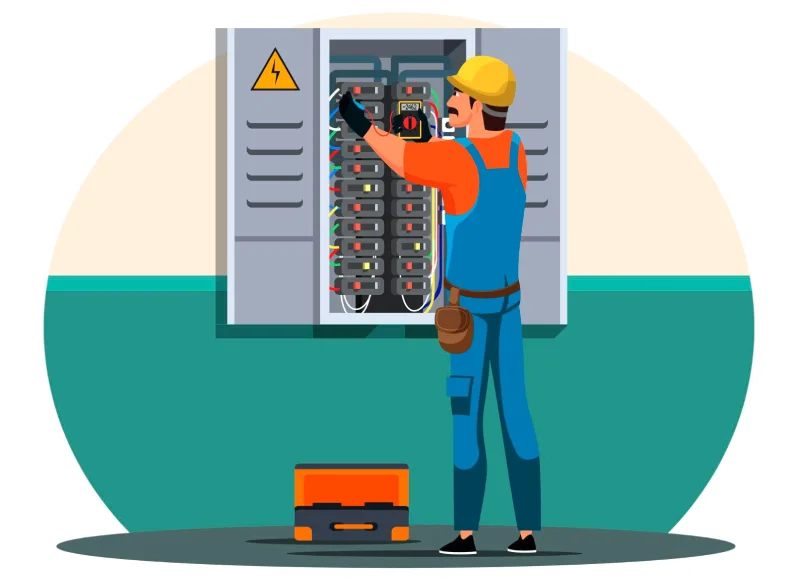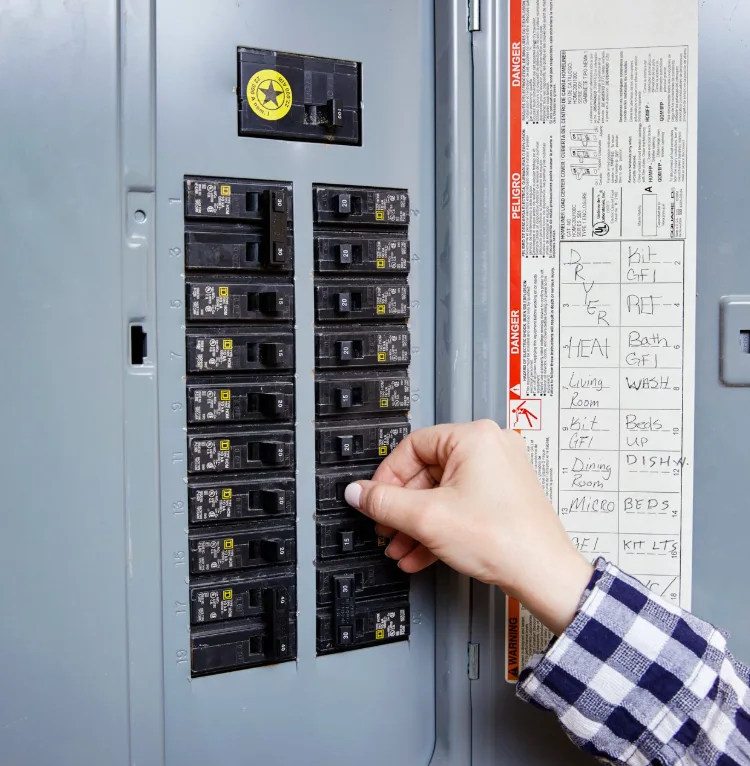Glavni odklopnik se običajno nahaja na vrhu vaše hiše električna plošča (odklopna omarica), ki se najpogosteje nahaja na zunanji steni, v kleti, garaži, pomožnem prostoru ali v bližini električnega števca. Razumevanje lokacije glavnega odklopnika je ključnega pomena za izklop električne energije v sili in električno varnost.
⚠️ VARNOSTNO OPOZORILOVedno bodite izjemno previdni v bližini električnih omaric. Če niste prepričani glede katerega koli električnega dela, se nemudoma posvetujte z pooblaščenim električarjem.
Kaj je glavni odklopnik in zakaj je lokacija pomembna?
Definicija glavnega odklopnika
A glavni odklopnik je primarni odklopnik ki nadzoruje vso električno energijo, ki vstopa v vaš dom iz komunalnega podjetja. Deluje kot glavno stikalo za izklop celotnega električnega sistema, običajno z nazivno močjo med 100 in 200 amperi za stanovanjske objekte.
Zakaj je poznavanje lokacije ključnega pomena
- Izklopi v sili med električnimi požari ali poplavami
- Priprava električnih del s strani izvajalcev
- Upravljanje porabe energije med nevihtami ali izpadi
- Skladnost z varnostnimi predpisi z lokalnimi električnimi predpisi
- Zahteve za inšpekcijski pregled doma za nepremičninske transakcije
Lokacija glavnega odklopnika glede na tip doma: Tabela hitrih referenc
| Vrsta doma | Najpogostejša lokacija | Sekundarne lokacije | Dostop do opomb |
|---|---|---|---|
| Enodružinska hiša | Garaža ali zunanja stena | Klet, pomožna soba | Običajno v višini oči |
| Mestna hiša/stanovanje | Notranja omara za gospodinjske pripomočke | Garaža, klet | Morda je skupna plošča |
| Apartma | Omara za kuhinjo/hodnik | Omara za spalnico | Pogosto označena številka enote |
| Mobilna hišica | Zunanja plošča blizu števca | Pomožno območje pod hišo | Škatla, zaščitena pred vremenskimi vplivi |
| Starejše hiše (pred letom 1960) | Klet blizu števca | Škatla z varovalkami namesto odklopnikov | Morda bo potrebna nadgradnja električnih naprav |
Vodnik po korakih za iskanje glavnega odklopnika
1. korak: Začnite z električnim števcem
- Pojdi ven in poiščite svoj električni števec (običajno nameščen na zunanji steni)
- Poglej v bližini za sivo ali rjavo kovinsko omarico (električno ploščo)
- Preverite v radiju 3 metre števca – koda zahteva neposredno bližino
2. korak: Preverite pogoste lokacije v notranjosti
- KletBlizu vstopa električnih vodov v hišo
- GaražaOb stenah, običajno nasproti vhoda v hišo
- Pomožna sobaPogosto v kombinaciji z grelnikom vode/opremo za ogrevanje, prezračevanje in klimatizacijo
- Kuhinjski prostorV starejših domovih, včasih v kuhinjskih omarah
- Omarice za hodnikŠe posebej v stanovanjih in etažnih lastninah
3. korak: Določite glavni odklopnik
- Odprite pokrov plošče (če je to varno storiti)
- Poiščite največji odklopnik – običajno na vrhu
- Preverite etiketo – mora pisati »MAIN« ali prikazovati najvišjo amperažo (100 A, 150 A, 200 A)
- Preverite, ali nadzoruje več vezij – ne samo ena vtičnica ali naprava
Nasvet strokovnjakaGlavni odklopnik je običajno dvakrat širši od standardnih odklopnikov in ima dve stikali, ki se premikata skupaj.
Glavne vrste in konfiguracije odklopnikov
Standardna glavna odklopna plošča
- LokacijaZgornji del električne plošče
- VidezDvojno široko odklopno stikalo
- Funkcija: Nadzira vso napajanje spodnjih pododklopnikov
- OcenaObičajno se ujema z zmogljivostjo plošče (100A–200A)
Glavna plošča s priključki (brez glavnega odklopnika)
- LokacijaNapajanje se krmili z zunanjim odklopnikom
- VidezV omarici ni glavnega odklopnika
- FunkcijaNeposredna povezava med števcem in razdelilno ploščo
- Varnostno obvestiloZa izklop je treba najti zunanji odklopnik.
Razdelilna plošča vodila (zastarela)
- LokacijaVeč glavnih odklopnikov v starejših razdelilnih ploščah
- Videz6 ali manj velikih odklopnikov na vrhu
- FunkcijaBrez enega glavnega zapornega ventila
- PriporočiloRazmislite o nadgradnji električne omarice
Varnostne zahteve in skladnost s predpisi
Nacionalni električni predpis (NEC) Zahteve
- VišinaSredišče plošče med 1,2 in 1,8 m od tal
- RazprodajaSpredaj: 36 palcev, v širino 30 palcev
- DostopnostNe more biti blokirano s shrambo ali pohištvom
- OznačevanjeVsi odklopniki morajo biti jasno označeni
- OzemljitevZahtevana je pravilna priključitev ozemljitvene palice
⚠️ Strokovno priporočiloNikoli ne odstranjujte pokrova glavne plošče, razen če ste usposobljen električar. Izpostavljene vodilne palice so pod smrtonosno napetostjo, tudi ko je glavno stikalo izklopljeno.
Postopki za izklop v sili
Kdaj uporabiti glavno stikalo za izklop
- Električni požari – Pred klicem na 112 takoj izklopite
- Poplave – Izklopite, preden voda pride v stik z električnimi komponentami
- Puščanje plina – Odstranite vire vžiga
- Večja električna dela – Zahtevano po kodeksu zaradi varnosti
- Priprave na nevihto – Preprečite poškodbe zaradi prenapetosti zaradi prenapetosti
Koraki za varno zaustavitev
- Zagotovite suhe pogoje – Električnih omaric se nikoli ne dotikajte z mokrimi rokami
- Stojte ob strani – Ne neposredno pred ploščo
- Uporabljajte izolirana orodja če je na voljo
- Izklopite glavno stikalo – Moral bi se trdno zaskočiti
- Preverite, ali je napajanje izklopljeno – Preverite luči in vtičnice
- Pokličite strokovnjake za električne težave
Odpravljanje težav: Kaj pa, če ne najdete glavnega odklopnika?
Pogosti scenariji in rešitve
ProblemV plošči ni vidnega glavnega odklopnika
- RešitevPoiščite zunanje stikalo za odklop v bližini števca
- Akcija: O potrebi po nadgradnji razvodne omare se posvetujte z električarjem.
ProblemVeč panelov v domu
- RešitevDoločite, kateri vsebuje vhodne vodnike za storitve
- AkcijaGlavni odklopnik je v prvi omarici za števcem
ProblemZmeda glede stanovanja/stanovanja
- RešitevPreverite najemno pogodbo ali se obrnite na upravo nepremičnine
- AkcijaLahko se nahaja v skupni električni sobi
ProblemZelo stara hiša z varovalka škatla
- RešitevPoiščite glavno varovalko ali nožno stikalo
- AkcijaRazmislite o posodobitvi električnih omar
Profesionalna namestitev in vzdrževanje
Kdaj poklicati pooblaščenega električarja
- Nadgradnje plošč od 100 A do 200 A
- Zamenjava glavnega odklopnika zaradi starosti ali poškodb
- Težave s skladnostjo s kodeksom odkrito med pregledom
- Utripajoče luči ali pogoste izklope odklopnikov
- Vonj po zažganem ali vidne poškodbe okoli plošče
Zahteve za certificiranje
- Licenco električar potrebno za vsa dela z glavnim odklopnikom
- Električna dovoljenja potrebno za modifikacije plošče
- Zahtevan pregled po večjih električnih spremembah
- Skladnost z zavarovanjem lahko zahteva profesionalno namestitev
Hitri kontrolni seznam za lokacijo glavnega odklopnika
Preden ga potrebujete
- [ ] Poiščite in preizkusite delovanje glavnega odklopnika
- [ ] Zagotovite prosto dostopno pot do električne omarice
- [ ] Jasno označite vse odklopnike
- [ ] Svetilko imejte v bližini električne omarice.
- [ ] Kontaktni podatki električarja za nujne primere
Pripravljenost na izredne razmere
- [ ] Poznajte natančno lokacijo glavnega odklopnika
- [ ] Izvedite postopek varnega izklopa
- [ ] Območje plošče naj bo prosto od skladišča
- [ ] Imejte na voljo rezervno razsvetljavo
- [ ] Vedite, kdaj poklicati strokovnjake
Pogosto Zastavljena Vprašanja
Na kaj morate biti pozorni pri iskanju glavnega odklopnika?
Glavno stikalo je običajno največje stikalo v električni omarici, ki se nahaja na vrhu in nadzoruje napajanje vseh drugih stikal. Običajno je nazivno na 100–200 amperov in je lahko označeno z »MAIN« ali pa prikazuje nazivno zmogljivost.
Kako vem, ali moj glavni odklopnik deluje pravilno?
Pravilno delujoče glavno stikalo mora trdno preklapljati med položajema VKLOP in IZKLOP, krmiliti napajanje celotnega doma in ne sme kazati znakov ožiganja, korozije ali ohlapnih povezav. Če opazite kakršne koli težave, se nemudoma obrnite na pooblaščenega električarja.
Ali lahko sam zamenjam glavno varovalko?
Ne. Zamenjava glavnega odklopnika zaradi varnostnih tveganj in predpisov zahteva pooblaščenega električarja. Delo na opremi za servisni vhod je lahko smrtno nevarno in lahko krši lokalne električne predpise in zavarovalne police.
Kakšna je razlika med glavnim odklopnikom in odklopniki?
Glavno stikalo nadzoruje vso električno energijo, ki vstopa v vaš dom iz električnega omrežja, medtem ko stikala nadzorujejo napajanje posameznih tokokrogov (luči, vtičnice, naprave). Glavno stikalo ščiti celoten električni sistem.
Kje je glavni odklopnik v starejših hišah?
Starejše hiše imajo lahko glavno stikalo v kleti blizu vhoda daljnovodov ali pa namesto sodobne razdelilne plošče z odklopniki uporabljajo omarico z varovalkami z glavno varovalko ali nožnim stikalom.
Kako pogosto je treba pregledovati glavne odklopnike?
Glavna stikala je treba strokovno pregledati vsake 3–5 let ali takoj, če opazite utripajoče luči, vonj po zažganem ali druge električne težave. Priporočljivo je, da lastniki stanovanj vsako leto opravijo vizualne preglede.
Kakšno ampersko moč naj bi imel glavni odklopnik?
Večina sodobnih domov uporablja glavna stikala z nazivnim tokom 150 A ali 200 A. Starejše hiše imajo lahko napajanje s tokom 100 A. Nazivna vrednost je odvisna od električnih potreb vašega doma in se mora ujemati z zmogljivostjo vašega vhoda za oskrbo s toploto.
Ali je varno izklopiti glavno stikalo med nevihto?
Da, izklop glavnega odklopnika med hudimi nevihtami lahko zaščiti električni sistem vašega doma pred prenapetostmi. Vendar to storite le, če lahko varno dosežete razdelilnik in ne stojite v vodi.
Povezano
Kaj je preklopno stikalo: popoln vodnik
GFCI proti AFCI: Popoln vodnik po električnih varnostnih odklopnikih




